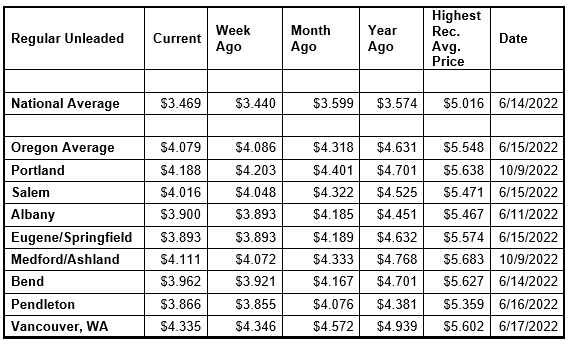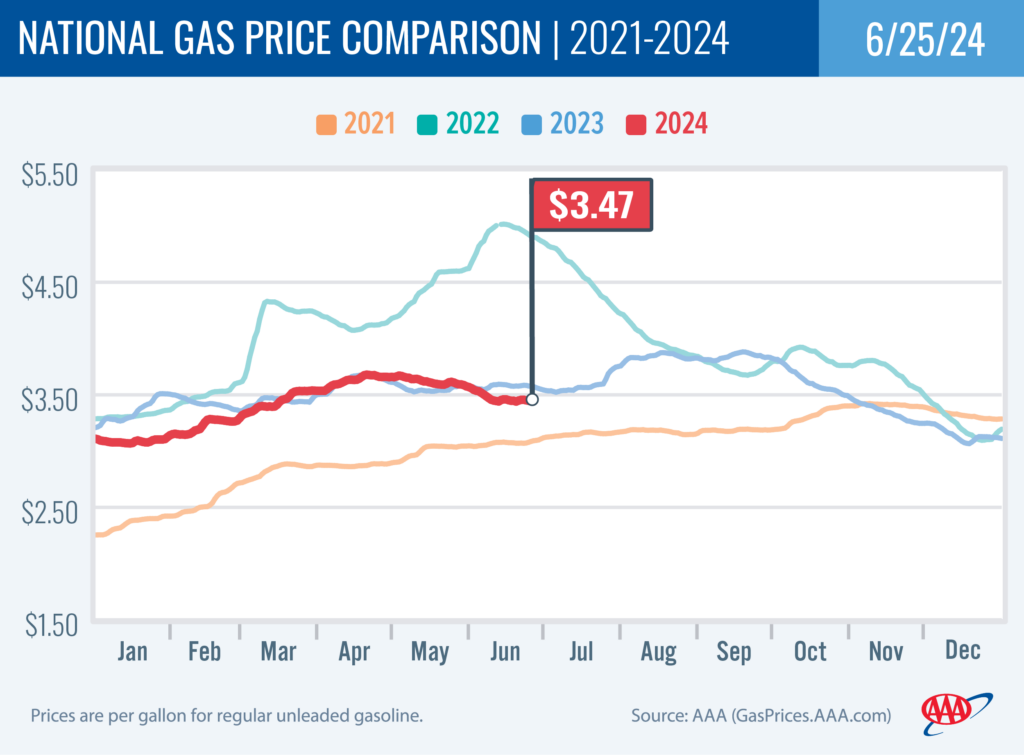PORTLAND, Ore., – Gas prices are showing little movement this week despite crude oil prices climbing back above $80 per barrel and an increase in demand for gas in the U.S. Oregon is one of 21 states with a small decline on the week, while other states are seeing small to moderate increases. For the week, the national average for regular adds three cents to $3.47. The Oregon average slips a penny to $4.08 a gallon.

“Gasoline demand in the U.S. is picking up as we approach the Independence Day holiday travel period. AAA expects record-setting travel for the 4th of July,” says Marie Dodds, public affairs director for AAA Oregon/Idaho. “With robust gasoline demand and an increase in crude oil prices, drivers could see pump prices tick up in the coming days.”
AAA projects 70.9 million Americans including 862,000 Oregonians will travel 50 miles or more from home over the week of July 4th. Find all the details, graphics and tips for travelers in the AAA Independence Day travel news release.
The national and Oregon averages are at the same prices as they were in March. This week, four Oregon counties have averages below $4 per gallon, up from two a week ago:
Baker $3.
Deschutes
Gilliam $3.90
Polk $3.
The Oregon average began 2024 at $3.79 a gallon compared to $4.08 today. Its lowest price so far this year is $3.58 on February 14 and the highest is nearly $4.51 on May 1. The national average started the year at $3.11 and is at $3.47 today. Its lowest price so far this year is just under $3.07 on January 15 and the highest is just under $3.68 on April 19.
Gas prices always rise starting in late winter through the spring as refineries undergo maintenance as the switch to summer-blend fuel occurs. The switch occurs first in California, which is why pump prices on the West Coast often rise before other parts of the country. The East Coast is the last major market to make the change to summer-blend fuel. Most areas have a May 1 compliance date for refiners and terminals, while most gas stations have a June 1 deadline to switch to selling summer-blend until June 1. Switch-over dates are earlier in California with some areas in the state requiring summer-blend fuel by April 1. Some refineries will begin maintenance and the switchover as early as February.
Crude oil prices have remained volatile due to geopolitical events around the world including the war between Israel and Hamas, the war between Russia and Ukraine, and Houthi militant attacks in the Red Sea. In addition, production cuts by OPEC+ have tightened global crude oil supplies. OPEC+ met on June 2 and, as expected, the cartel will extend production cuts into the third quarter.
The price of crude oil reached the year-to-date high of nearly $87 per barrel on April 5. West Texas Intermediate climbed above $80 on March 14 and above $85 on April 2, then dipped below $85 starting on April 17 and below $80 again on May 1. WTI rose above $80 per barrel again on June 17 and has remained above $80 since then. Major drivers of elevated crude prices are the unrest in the Middle East, the decision by OPEC+ to keep oil production cuts in place, and Ukrainian attacks on Russian refineries. Russia is a top global oil producer and the refinery attacks have reduced output.
Crude prices have been volatile after the attack on Israel by Hamas in October. While Israel and the Palestinian territory are not oil producers, concerns remain that the conflict could spread in the Middle East, which could potentially impact crude production in other oil-producing nations in the region.
Crude oil is trading around $81 today compared to $80 a week ago and $69 a year ago. In 2023, West Texas Intermediate ranged between $63 and $95 per barrel. Crude reached recent highs of $123.70 on March 8, 2022, shortly after the Russian invasion of Ukraine, and $122.11 per barrel on June 8, 2022. The all-time high for WTI crude oil is $147.27 in July 2008.
Crude oil is the main ingredient in gasoline and diesel, so pump prices are impacted by crude prices on the global markets. On average, about 55% of what we pay for in a gallon of gasoline is for the price of crude oil, 19% is refining, 12% distribution and marketing, and 14% are taxes, according to the U.S. Energy Information Administration.
Demand for gasoline in the U.S. rose from 9.04 million b/d to 9.39 million b/d for the week ending June 14, according to the U.S. Energy Information Administration (EIA). This compares to 9.38 million b/d a year ago. Meanwhile, total domestic gasoline stocks declined from 233.5 to 232.2 million barrels.
Higher demand, decreasing gasoline stocks and crude oil prices above $80 could put upward pressure on pump prices.
Quick stats
Oregon is one of 21 states and the District of Columbia with lower prices now than a week ago. Maryland (-6 cents) has the biggest weekly drop in the nation. Florida (+17 cents) has the largest week-over-week increase.
California ($4.82) has the most expensive gas in the nation for the 17th week in a row. This is the third week in a row that the California average has been below $5 per gallon. Hawaii ($4.71) is second, Washington ($4.33) is third, Oregon ($4.08) is fourth, and Nevada ($4.06) is fifth. These are the five states with averages at or above $4 a gallon, same as a week ago. This week 43 states and the District of Columbia have averages in the $3-range. There are two states with averages in the $2 range this week.
The cheapest gas in the nation is in Mississippi ($2.93) and Arkansas ($2.95). No state has had an average below $2 a gallon since January 7, 2021, when Mississippi and Texas were below that threshold.
The difference between the most expensive and least expensive states is $1.89 this week, compared to $1.91 a week ago.
Oregon is one of 48 states and the District of Columbia with lower prices now than a month ago. The national average is 13 cents less and the Oregon average is 24 cents less than a month ago. This is the fifth-largest month-over-month decline in the nation. Alaska (-38 cents) and California (-31 cents) have the largest monthly drops. New Mexico (+4 cents) and Colorado (+1 cent) are the only states with month-over-month increases.
Oregon is one of 43 states and the District of Columbia with lower prices now than a year ago. The national average is eight cents less and the Oregon average is 55 cents less than a year ago. This is the second-largest year-over-year drop in the nation. Washington (-65 cents) has the largest yearly decrease. Indiana (+11 cents) has the largest year-over-year increase.
West Coast
The West Coast region continues to have the most expensive pump prices in the nation with all seven states in the top 10. It’s typical for the West Coast to have six or seven states in the top 10 as this region tends to consistently have fairly tight supplies, consuming about as much gasoline as is produced. In addition, this region is located relatively far from parts of the country where oil drilling, production and refining occurs, so transportation costs are higher. And environmental programs in this region add to the cost of production, storage and distribution.
| Rank | Region | Price on 6/25/2024 |
| 1 | California | $4.82 |
| 2 | Hawaii | $4.71 |
| 3 | Washington | $4.33 |
| 4 | Oregon | $4.08 |
| 5 | Nevada | $4.06 |
| 6 | Alaska | $3.91 |
| 7 | Illinois | $3.86 |
| 8 | District of Columbia | $3.66 |
| 9 | Pennsylvania | $3.63 |
| 10 | Arizona | $3.60 |
As mentioned above, California has the most expensive gas in the country for the 17th week in a row. Hawaii, Washington, Oregon, Nevada, and Alaska round out the top six. Arizona is 10th. Oregon is fourth most expensive for the sixth week in a row.
Six of the seven states in the West Coast region are seeing small week-over-week declines: Arizona (-4 cents), Hawaii (-3 cents), Alaska (-3 cents), California (-1 cent), Washington (-1 cent), and Oregon (-1 cent). Nevada (+1 cent) is the only state in the region with a weekly increase.
The refinery utilization rate on the West Coast increased from 89.7% to 91.0% for the week ending June 14. This rate has ranged between about 74% to 97% in the last year. The latest national refinery utilization rate decreased from 95.0% to 93.5%. The refinery utilization rate measures how much crude oil refineries are processing as a percentage of their maximum capacity. A low or declining rate can put upward pressure on pump prices, while a high or rising rate can put downward pressure on pump prices.
According to EIA’s latest weekly report, total gas stocks in the region dipped from 31.11 million bbl. to 30.40 million bbl.
An increase in the refinery utilization rate and/or a high rate can put downward pressure on pump prices, and a decrease in gasoline stocks can put upward pressure on pump prices.
Oil market dynamics
Crude oil prices rallied much of last week, then dipped on Friday. Crude prices are up to start this week. Crude prices were buoyed by tensions in the Middle East, with a conflict between Israel and Hezbollah on the Lebanon border. In addition, the EIA reports that crude oil inventories in the U.S. decreased by 2.5 million barrels from the previous week. At 457.1 million barrels, U.S. crude oil inventories are 4% below the five-year average for this time of year.
At the close of Friday’s formal trading session, WTI fell $1.44 to settle at $80.73. At the close of Monday’s formal trading session, WTI rose 90 cents to settle at $81.63. Today crude is trading around $81 compared to $80 a week ago. Crude prices are about $12 more than a year ago.
Drivers can find current gas prices along their route with the free AAA Mobile app for iPhone, iPad and Android. The app can also be used to map a route, find discounts, book a hotel and access AAA roadside assistance. Learn more at AAA.com/mobile.

Diesel
For the week, the national average gains two cents to $3.80 a gallon. The record high is $5.816 set on June 19, 2022. The Oregon average adds one cent to $4.09. The record high is $6.47 set on July 3, 2022. A year ago the national average for diesel was $3.89 and the Oregon average was $4.44.
Find current fuel prices at GasPrices.AAA.com.
AAA news releases, high resolution images, broadcast-quality video, fact sheets and podcasts are available on the AAA NewsRoom at NewsRoom.AAA.com.
Find local news releases at https://oregon.aaa.com/community/media/media-contacts.html
Fuel prices are updated daily at AAA’s Daily Fuel Gauge at AAA Gas Prices. For more info go www.AAA.com. AAA Oregon/Idaho provides more than 900,000 members with travel, insurance, financial and automotive-related services, and is an affiliate of AAA National, serving more than 64 million motorists in North America.

